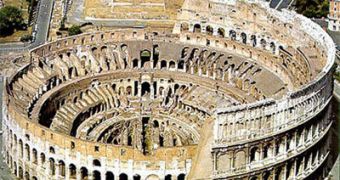Greek theaters were carved in one side and open to nature on the other side. But the Roman theaters had a circular disposition: they were amphitheaters. The most impressive and famous is the Colosseum, built in 80 AD. In 2007, people around the world chose it as one of the new Seven Wonders of the World. The Colosseum could have resisted in perfect state if it had not been plundered, and it still thrones in the heart of Rome. All was made on stone, timber and... concrete.
The Colosseum was started by Flavius Vespasian and inaugurated by emperor Titus (when it was still unfinished) in 80 AD. It was ended during the rule of emperor Domitian (81-96 AD) in 82. Domitian was a fearful enemy of the Christians, and sent thousands of them to die in the arena of the Colosseum.
The proportions of Colosseum are indeed colossal, being the largest Roman amphitheater ever, but its name comes from a colossal statue of Nero placed in its front. The statue did not resist time.
This amphitheater was 190 m (633 ft) long and 155 m (516 ft) wide. The Colosseum had 80 entrance arches, of which three were reserved for the emperor and officials. The spectators acceded to the superior levels through narrow stairs. The whole amphitheater could capacitate about 50,000 to 80,000 persons (but it had only 45,000 seats).
The downstairs were reserved for the most important spectators. There were special tribunes, one for the emperor and the others for the important people. The last series of seats, at the highest level, were made of wood.
An exaggerated pomp seems to have accompanied some games. Pliny the Elder said in his "Natural History" that the furniture was covered by gold, silver and amber. The seats had soft pillows, and everywhere were wells bringing cold water, while the air was refreshed by pulverizing water with saffron and perfumes wasted with ostentation, to show the generosity of the emperor.
Arena means "sand" in Latin. The arena was a wooden floor covered by sand, which absorbed the blood of the victims. A palisade that protected the public from the attack of the beasts surrounded it. There were two exits, one of them serving for evacuating the dead gladiators and beasts. The other one was the entrance gate for the procession of gladiators parading in front of the emperor and public before the combat. They greeted "Ave Caesar, morituri te salutant!" (Cesar, those who are going to die greet you!).
Beneath the arena, there were sewers, cages, pits, and corridors. This system of lifting-carrying was invisible for the spectators, transporting people and beasts to the arena. A machinery allowed the transport of the water, turning the arena into an artificial lake for naval fights.
The Colosseum had circular corridors (a corridor was called ambulacrum - "avenue", "promenade") at each level, that allowed the spectators to occupy their seats. Entrances allowed people to pass from the corridors to the seat rows. Everything was so well planned that the Colosseum could be evacuated in just 15 minutes.
At the last level, posts were installed so that they could support a huge canvas (velum), usually decorated with the portrait of the emperor and aimed to protect the spectators. 100 people were required for controlling the velum.
At the inaugural munera (games with gladiators and animals) of the Colosseum, Titus sacrificed 5,000 beasts, while in two munera, the emperor Trajan (98-117 AD) sacrificed 2,246, respectively 2,243 animals. The emperor Hadrian (117-138 AD) is said to have descended into the arena of the Colosseum and to have killed a lion bare-handed.
In 248 AD, at the celebration of the Rome's secular games, just 32 elephants, 10 tigers, 60 lions, 30 leopards, 10 hyenas, 6 hippopotamus, 10 zebras, 1 rhinoceros, 10 giraffes, 50 wild donkeys, and 1,000 pairs of gladiators passed through the Colosseum. This is little as compared to Trajan's 11,000 beasts and 10,000 gladiators.
Not only gladiators fought in the Colosseum. Convicts and war prisoners too could be made to fight for their lives in the arena of the Colosseum. The gladiator combats were forbidden in 404 AD. During the 6th century, animal fights ceased as well.

 14 DAY TRIAL //
14 DAY TRIAL //